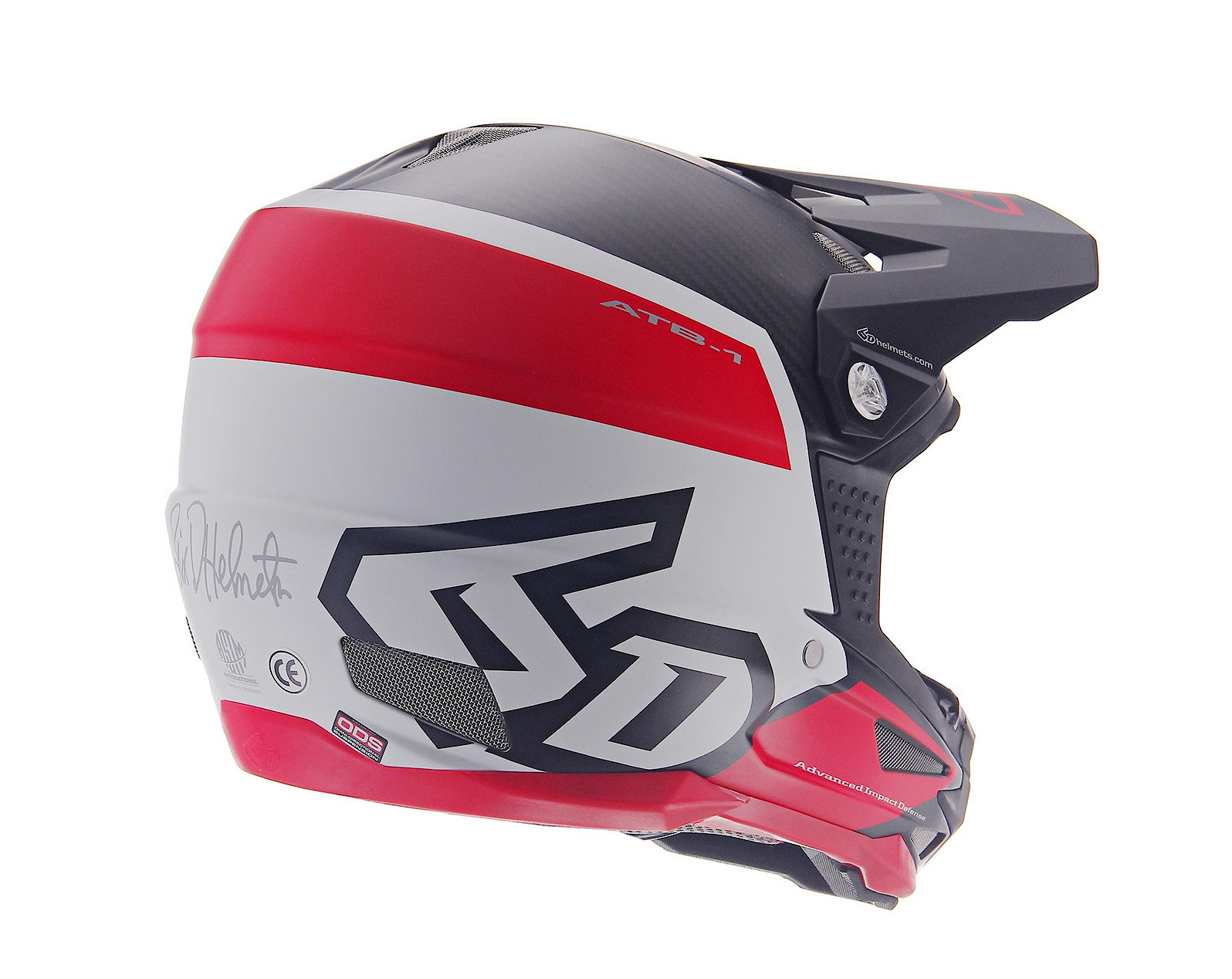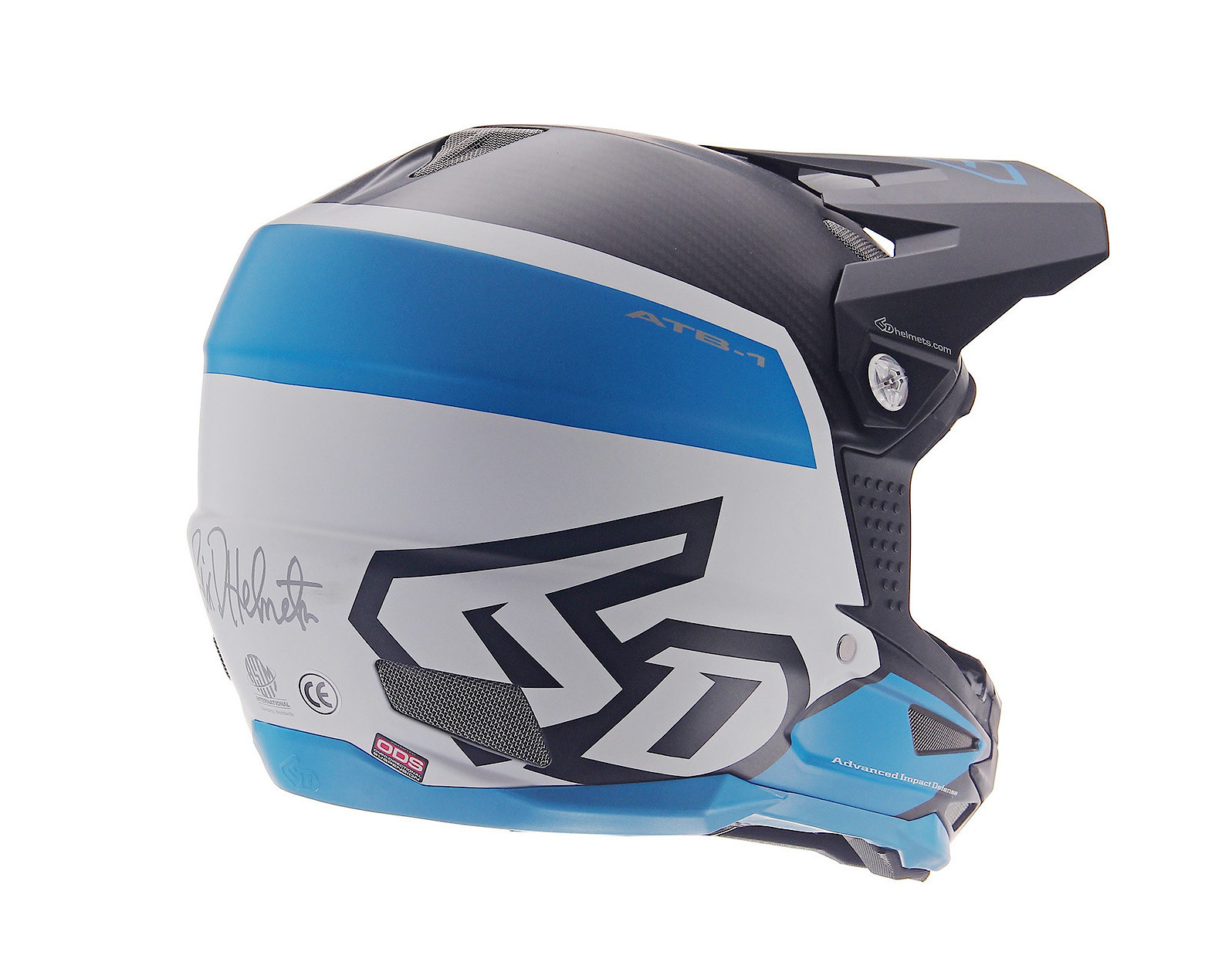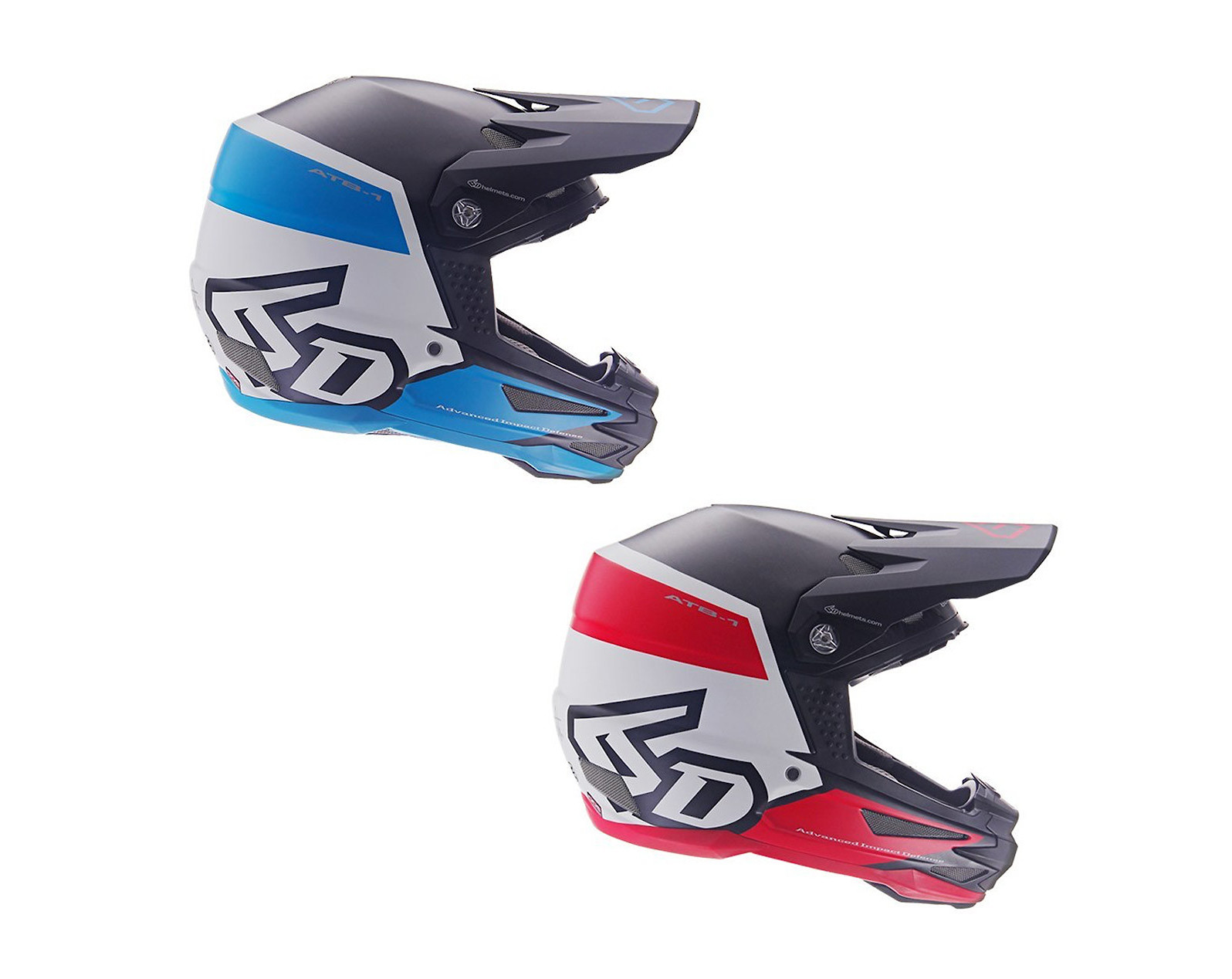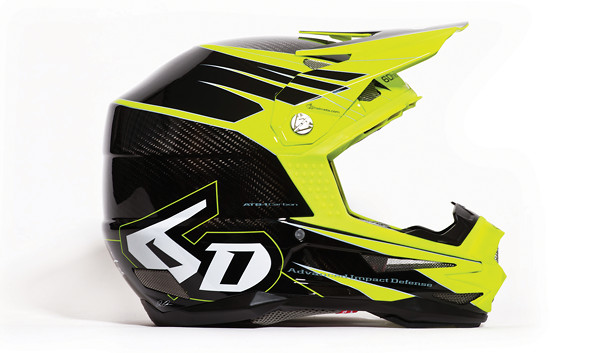6D ATB-1 Full Face Helmet
| Where To Buy | |||
|---|---|---|---|
Free shipping on orders over $50 (continental U.S. only).
International shipping available. Some exclusions apply. |
|||
Free Delivery on purchases over £20.
|
|||

Review by Jeff Brines // Action photos by Matthew Doherty
When it comes to function, downhill-oriented mountain bike helmets have remained more or less the same over the last decade. Helmets have become better looking, helmets have become lighter and in some cases, such as inclusion of MIPS, helmets have become marginally better at protecting your head. But, for the most part, helmets haven’t changed too much. New comer to the mountain bike space, 6D, has launched their ATB-1 full face helmet, which aims to make a marked improvement when it comes to noggin floggin'. This is not a mail-order, re-branded generic helmet, but a uniquely designed and potentially game-changing dome protector with some very interesting proprietary technology.
As someone who almost had his riding “career” nearly halted decades earlier due to an “atypical concussion,” our tester was thrilled to see a company seek out a way for a helmet to absorb more energy. After learning more about their helmets, we started thinking “6D isn’t a helmet company, it’s a suspension company for your head.” What does 6D do different and how did it perform? Read on to find out…
ATB-1 Full Face Highlights
- Patented ODS (Omni-Directional Suspension) Technology
- SHELL – Advanced aerospace 3K CARBON FIBER
- New PC Halo – Improves durability of inner EPS liner and overall performance
- Air Flow Management – 10 intake ports, 13 transfer ports and 4 aggressive exhaust ports
- Rear Delta-Vent– Aids heat transfer by scavenging air
- SuperCool Comfort Liner – Genuine CoolMax anti-bacterial fabric exclusive to the ATB-1
- Emergency Release Cheek Pads - With SuperCool foam
- Shear-away Visor Screws
- Roost Guard – Provides additional face protection
- Clavicle Cut-Away – Provides increased clavicle clearance without sacrificing strength
- Sternum Pad – Provides added protection of the chin, jaw and sternum in the event of an accident
- Exceeds ASTM F-1952-10 and CPSC 16CRF 1203 standards
- Weight: +/- 1,310 grams
- 3-Year Limited Warranty
- Crash Replacement / Rebuild Program
- MSRP $649

6D offers full faced helmets for everything from street bikes to BMX. The materials they use and intended application changes model to model, but the company’s ODS Energy Management Technology is carried down throughout the their offerings.
ODS Energy Management Technology is the 6D special sauce which makes these helmets so unique. The basics are as follows: there are two separate liners within the helmet that are held together by 27 precisely placed elastic isolation dampers (think of the same spring within the RockShox Indy C). In the event of a crash, these elastomers are able to absorb more energy, regardless of impact speed, than a conventional foam liner. Additionally, the dampers are able to absorb impacts in a number of directions, something akin to what MIPS does, only on a much bigger scale. To put it another way, the helmet does offer “rotational float” in the event of a twisting crash, which most crashes involve, as well as blunt force impact.

The elastomers were designed in an hourglass shape to provide more of a progressive spring rate to be somewhat supple off the top with a ton of support at the bottom. What does this mean for your head? It means the helmet will be able absorb more energy in both small and big impacts alike, unlike more conventional helmets. Conventional helmets are more or less “tuned” to one impact speed, sort of like a really specific fork setup from 1995. Too soft a hit and the helmet acts like a rigid fork. Too hard a hit and the helmet acts like a kids fork. 6D's helmets, on the other hand, are able to differentiate between impact speed through utilization of these elastomers.
All this technology is great, but what does it translate to? The company’s website is littered with independent lab results comparing the 6D ATB-1 to the competition. Not surprisingly, the helmet is shown to do a better job absorbing energy in every type of crash. In some cases, the tests show the helmet has twice the ability to absorb energy compared others in the test. One thing seems clear, the helmet allows your brain to come to a “stop” over a longer period of time, thus reducing damage. It goes without saying, better you shear a helmet's elastomers than shear your brain’s axons.

A word on “standards” before we go any further. If you look at our Bell Feature MIPS review, you’ll note we did a little homework on helmet standards. The fact is, current helmet standards are pretty outdated and were designed an entire generation of neuroscience ago. What we're driving at is there is no “platinum” standard for helmet companies to strive for, just a "D-" grade they must achieve to be sold in the United States. Despite what you may have been told by the sales guy at the shop, not all helmets are the same when it comes to head protection, and for the most part, it's hard to tell objectively which are better than others. 6D’s independent testing is a start, but it’d sure be nice to see a non-profit entity comprised of passionate neuroscientists/engineers to provide a new standard all together. A "Michelin 5-star of helmets" kind of rating. We can dream, right?

On The Trail
Unlike Kidwoo, we do our best to not test helmets in real life. To be honest, any head bonk – helmet or not – is bad. To add, it'd be extremely anecdotal for us to comment on a crash and say whether or not the helmet did its job. Let that be for the lab. Thankfully, this helmet has not seen the wrong side of the trail yet. That said, we have put a number of days in the lid and can report a few findings.
First things first. The helmet's lines are clean, the graphics are fairly neutral and look enticing. That said, it is far more bulbous than the likes of the more conventional, svelte mountain bike helmets. It looks a lot more like a DOT-approved moto helmet than your typical DH-specific helmet, not that there is anything wrong with that. Do note, however, this helmet is not DOT approved. Either way, we're a form-follows-function kind of group...to a point, of course. This helmet is bigger and there is a reason for that – the elastomers and better protection. Overall, we give this thing kudos in the looks department, though it may look a bit "funny" on smaller riders.

The helmet has a snug fit. Our tester measures 58cm (ahem, ladies, huge brain) which puts him in between a medium and large lid. Even with his George-Costanza-like-hair-loss (classic horseshoe pattern…probably only have 9 months), the medium fits snugly. So snug, we might have opted to go to a large for our tester's dome. We're not going to make the claim that if you are between sizes to “size up,” but we are suggesting you try this one on before pulling the trigger.
The good news is, even with our testers between-sized noggin and tight fit, the helmet was still fairly comfortable. Our guess is the padding will continue to pack out a bit as the helmet is worn more for an even better fit; sizing crisis averted.
Sizing woes aside, the helmet was fairly invisible once on our head. You aren’t going to fool yourself into thinking you are wearing some enduro hybrid lid, but we never felt the slight weight penalty over the competition (about 150 grams heavier than a D3) while doing proper DH laps. On that note – this is a DH helmet and is not meant to be a trail helmet with face protection. It can be carried and utilized as such but we wouldn’t suggest it, just as we wouldn’t suggest riding your DH steed on mellow singletrack.
Ventilation, however, is a different story. This helmet does not run super cool. Our tester was okay with that, being he lives in Jackson, WY, where he rarely see temps into the mid-80's. For desert dwellers, this will likely be a hot helmet – something akin to a full DOT moto helmet. When our tester was asked if he'd go a different direction, his answer was no. "Full face helmets are going to be hot. This is a true DH lid, not something you’ll wear on a trail ride. As long as it's utilized as it was intended, like ripping down a trail and taking it off for the ride back up, it does just fine when it comes to cooling."
Unfortunately, the biggest knock to the helmet is the design of the jaw/face protector, specifically the way it is ramped. Without utilizing a snowmobile style breath deflector, our goggles would fog at a stop and it felt as though we were breathing right in our own face, which is sort of a suffocating feeling. There may be a remedy to this, but it was annoying, especially while standing still after a big effort. At speed, it wasn’t as noticeable, especially while cruising, but, at sustained efforts it did continue to be a bit of a bother. Maybe we just need to huff and puff less!
Long Term Durability
If you konk your head hard, get a new helmet. The whole premise is that it's “designed to fail.” That said, the helmet is holding up to “normal use” very much to par. No complaints here.
Things That Could Be Improved
For this to be a 5-star product, the helmet’s mouthpiece needs to be revised to allow better “exhaust” while breathing. Second to that, the price is higher than anything out there, at $649. While we would argue that the increase in complexity does justify a price increase, this may be a bit much for a number of riders to stomach. Which is too bad, as the helmet maybe game changing and deserving of the 5-star rating, otherwise.

What's The Bottom Line?
You only have one brain. The 6D ATB-1 may arguably be the best preventative tool with respect to all types of brain injury, from large to small, on the market. While this may not be the most svelte or sexiest helmet out there, it’s the one we are going to grab anytime things get spicy. We applaud 6D for putting investment into developing a new technology to protect the most important part of your body. We look forward to seeing more objective testing regarding what could be the most significant piece of brain protection in the last 30 years.
Visit 6dhelmets.com for more details.
About The Reviewer
Jeff Brines didn't go on a real date until he was nearly 20 years old, largely as a result of his borderline unhealthy obsession with bicycles. Although his infatuation with two wheels may have lead to stuttering and sweatiness around the opposite sex, it did provide for an ideal environment to quickly progress through the ranks of both gravity and cross-country racing. These days, Jeff races enduro at the pro level, rides upward of 150 days a year while logging over 325k of human powered ascending/descending on his bike. Bred as a racer, Jeff is more likely to look for the fastest way through a section as opposed to the most playful. Living in the shadow of the Tetons in Jackson, WY, Jeff works in financial intelligence and spends his winters as head ski gear guru and content manager over at earlyups.com.
Specifications
Advanced Carbon Fiber Shell
Large Eyeport Opening
Contoured Roost Guard
Integrated Traction Posts at the Eyeport
Clavicle Cut-Away
Shear-Away Visor Screws
Stainless Steel "D" Rings and Chin Strap Rivets
Stainless Steel Screens Protect All Shell Openings
Emergency Release Cheek Pads
Sternum Pad
2015: White, Yellow, Black with Attack Graphic
3-Year Limited Warranty
| Where To Buy | |||
|---|---|---|---|
Free shipping on orders over $50 (continental U.S. only).
International shipping available. Some exclusions apply. |
|||
Free Delivery on purchases over £20.
|
|||









































13 comments
Post a reply to: Tested: 6D ATB-1 Full Face Helmet